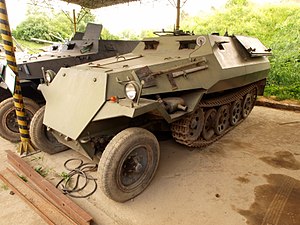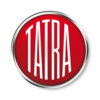OT-810
| OT-810 | |
|---|---|

Czech OT-810 in the Vojenské muzeum na demarkační linii |
|
| General properties | |
| crew | 2 + 10 |
| length | 5.71 m |
| width | 2.10 m |
| height | 1.88 m |
| Dimensions | 9 tons |
| Armor and armament | |
| Armor | 12 mm (front), 8 mm (side) |
| Main armament | 1 × 7.62 mm machine gun vz. 59 , (other versions recoilless anti-tank gun ) |
| agility | |
| drive | a Tatra eight-cylinder diesel engine type 928-3 130.5 hp |
| Top speed | 55 km / h (road) |
| Power / weight | 14.4 hp / ton |
| Range | 600 km |
The OT-810 was a Czechoslovak armored personnel carrier that was built on the chassis of the Sd.Kfz. 251 based on the German Wehrmacht . The abbreviation OT stands for Obrněný transportér , i.e. armored personnel carrier . It was first introduced in the Czechoslovak People's Army in 1958 and was superseded by the OT-62 and OT-64 .
history
During the Second World War , the Škoda plant in Pilsen was already producing Sd.Kfz. 251 built. In addition, vehicles captured and reused after the war were maintained or modernized here. Looking at the past war, the new Czechoslovak Army recognized that armored personnel carriers are an important part of modern warfare. War stocks of the Sd.Kfz.251 were used as HKL-6 by the Czechosovak People's Army as early as the late 1940s . Production of the OT-810 as an improved version of it began in 1958 and ended in 1962. In this short time, around 1500 vehicles were built, which were used in the motorized rifle companies instead of the BTR-152 . In addition there were countless HKL-6s that were converted to the status of the OT-810. The vehicle was used as a group vehicle in Czechoslovakia until 1966 and after the introduction of the successor OT-62 and OT-64 it was still used as a traction device for the 82 mm light gun. The vehicle was finally taken out of service in the 1980s.
With the OT-810 a new beginning was made possible especially for the low-lying Czech arms industry.
technology
The vehicle was possibly - with the exception of the Chilean BMS-1 Alacran from 1983 - the only half-track vehicle produced after the war . The vehicle was based on the D version of the Wehrmacht model. The vehicle had the same chassis with box drive and the front axle with tires for steering assistance. The power was only transmitted to the chain. Changes to the German model consisted primarily in the introduction of an eight-cylinder diesel from Tatra , which replaced the German Maybach engine. This increased the range from 320 km to 600 km. For the first time, the armored personnel carrier was completely closed and thus offered protection from chemical weapons , from radioactive fallout and above all from weapons such as hand grenades , Molotov cocktails and artillery fragments. The armored box was made of 8-12 mm thick steel and was bevelled to provide more protection. The vehicle commander had a roof hatch on which a slewing ring with a machine gun was attached. Shooting hatches were provided for firing weapons from the closed vehicle.
Others
In films about World War II, that was Sdfz. 251 was difficult to obtain as a prop after 1945 and was mostly represented by the M3 half-track vehicle . In some cases, such as in Die Brücke von Remagen , Stalingrad or Der Untergang , vehicles of the type OT-810 could be procured for this role. They can be recognized through the closed roof.
literature
- Military vehicles, Atlas Verlag
